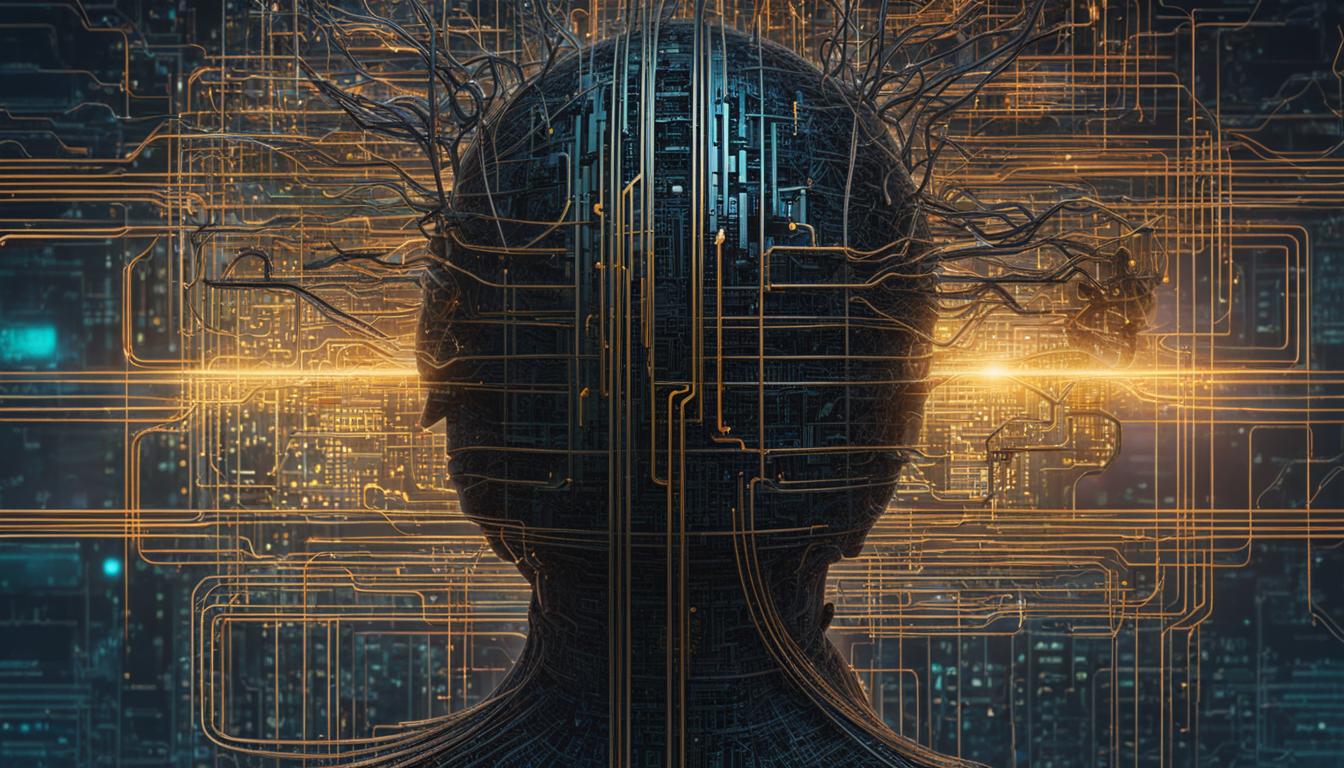Welcome to our article on AI learning! Here, we will delve into the intriguing realm of artificial intelligence and its ability to learn. We will be discussing the insights and studies presented at the recent autumn conference held by the Stanford Institute for Human-Centered Artificial Intelligence. This gathering brought together specialists from diverse backgrounds to examine how AI algorithms can enhance their common sense abilities, how robots can expand their learning capabilities, and the impact of a child’s learning approach on AI. Come along with us as we uncover the potentials of AI learning!
Key Takeaways:
- AI learning was a prominent topic at the Stanford fall conference on human-centered artificial intelligence.
- DeepMind’s research on deep reinforcement learning showcases the power of AI neural networks.
- Understanding the brain and cognition can lead to better AI models.
- Robots can learn to generalize their knowledge through visual demonstrations.
- Machine learning is driving advancements across various industries.
The Power of Deep Reinforcement
Deep reinforcement learning is revolutionizing the field of artificial intelligence (AI). By combining deep neural networks with the principles of reinforcement learning, researchers are unlocking new capabilities and achieving remarkable results. Matthew Botvinick, director of neuroscience research for DeepMind, discussed the power of deep reinforcement learning in AI applications.
DeepMind, a leading AI research lab, has leveraged deep reinforcement learning to train machines to play classic Atari games at superhuman levels. Building on this success, they expanded their approach to tackle more complex games like StarCraft and Go, and even ventured into the realm of multi-agent games like Capture the Flag. Through deep reinforcement learning, these AI systems are able to learn and improve their strategies, making better predictions and achieving exceptional performance.
One of the key insights driving these advancements is the understanding of dopamine-based reinforcement learning, which is inspired by how the human brain processes rewards. DeepMind researchers are utilizing this knowledge to train AI neural networks, allowing the systems to make more accurate predictions. By incorporating insights from the human brain, these AI models are becoming more intelligent and capable of solving complex problems.
“Our research has shown that deep reinforcement learning can bring AI to new levels of performance and effectiveness,” says Botvinick. “By combining the power of deep neural networks with the principles of reinforcement learning, we are unlocking the true potential of AI.”
The Future of AI Predictions
With deep reinforcement learning, the possibilities for AI applications are vast. From gaming to robotics, this approach is allowing machines to learn and adapt in dynamic and challenging environments. As researchers continue to push the boundaries of deep reinforcement learning, we can expect further breakthroughs in AI predictions and problem-solving capabilities.
| Applications | Benefits |
|---|---|
| Gaming | Superhuman performance |
| Robotics | Adaptive learning in complex environments |
| Finance | Improved risk management and investment strategies |
| Healthcare | Enhanced diagnosis and treatment planning |
Deep reinforcement learning is propelling AI into new frontiers, enabling machines to learn and make predictions in ways that were once thought impossible. The integration of deep neural networks and reinforcement learning principles holds tremendous potential for solving complex problems and driving innovation across various industries. As researchers continue to advance the field, we can expect AI predictions to become increasingly accurate and powerful.
A Two-Way Modeling Approach
In our quest to create more advanced AI systems, we have embarked on a two-way modeling approach that aims to foster a better understanding of the brain and cognition, while also leveraging AI to enhance our knowledge of human intelligence. By bridging the gap between cognitive science and AI, we are unlocking new possibilities for creating more intuitive and intelligent machines.
Modeling the Human Visual System
One key aspect of our approach involves modeling the human visual system using AI. By developing optimized models that mimic how the brain processes visual information, we can gain valuable insights into how our own visual system functions. This allows us to create AI systems that can better perceive and interpret visual stimuli, leading to advancements in fields such as computer vision and object recognition.
Furthermore, by comparing our AI models with actual brain functioning, we can identify areas where our understanding may be incomplete or where our models can be improved. This iterative process of learning from both AI and the brain helps us refine our models and gain a deeper understanding of how the human visual system works.
Applying Insights from Cognitive Science
In addition to modeling the brain, we also draw inspiration from cognitive science to develop AI models that exhibit curiosity and intuitive physics. By studying how infants learn and interact with their environment, we can apply these insights to our AI systems, enabling them to learn and adapt in a more human-like manner.
By incorporating cognitive science principles into our AI models, we are constantly pushing the boundaries of what machines can do. AI systems that embody curiosity and intuitive physics have the potential to revolutionize fields such as robotics, where machines can better understand and navigate the physical world, making them more capable and adaptable.

By adopting a two-way modeling approach, we are not only advancing the field of AI but also deepening our understanding of the human mind. As we continue to explore the possibilities that arise from this synergy between AI and cognitive science, we are paving the way for more intelligent and intuitive machines that can truly revolutionize the way we live and work.
Improving Generalization with General Training
In our quest to develop more intelligent AI systems, one crucial challenge we face is improving the generalization capabilities of these machines. While AI algorithms have shown impressive learning abilities in specific tasks, they often struggle to apply the acquired knowledge to new and unfamiliar scenarios. To address this issue, our team, led by Stanford assistant professor Chelsea Finn, is focused on training AI applications to generalize their learning, much like humans do.
Our research has shown that providing robots with visual demonstrations can greatly enhance their ability to learn and generalize. By observing real-world examples, robots can extract valuable information and apply it to similar situations, improving their adaptability and problem-solving skills. This approach has proven to be highly effective, resulting in faster and more generalized learning.
As part of our efforts to advance the field, we are also working on creating a comprehensive database called RoboNet. This database will facilitate the sharing of learning-related videos across institutions, allowing robots to learn from a wide range of experiences and perspectives. By leveraging the collective knowledge of AI researchers and practitioners, we hope to accelerate the development of robust and intelligent AI systems.
| Benefits of Visual Demonstrations for Robots |
|---|
| Enhanced learning abilities |
| Improved generalization skills |
| Increased adaptability |
| Accelerated problem-solving capabilities |
By combining visual demonstrations and collaborative knowledge sharing, we believe that we can empower AI systems to learn and generalize in a way that closely resembles human learning. This is a significant step forward in the development of AI technologies that can adapt and thrive in complex and dynamic environments.
Unlocking the Potential of General Training
General training, supported by visual demonstrations and collaborative learning, holds immense potential for the future of AI. By enabling robots to learn from a vast array of experiences and perspectives, we can equip them with the skills necessary to navigate real-world scenarios with confidence and efficacy.
As our research continues, we are excited to see the impact of improved generalization on AI applications across various industries. From manufacturing and healthcare to transportation and entertainment, the ability to learn and generalize will revolutionize the capabilities of AI systems, opening up new possibilities and transforming the way we interact with technology.
As we strive to unlock the full potential of AI, it is essential to prioritize efforts that enable machines to learn and generalize. By doing so, we can create AI systems that are not only highly proficient in specific tasks but also capable of adapting and thriving in the face of new challenges.

| Advantages of Modeling Human Intelligence | Challenges of Modeling Human Intelligence |
|---|---|
|
|
Learning While Protecting Privacy
When it comes to the advancement of artificial intelligence (AI), data privacy has become a paramount concern. As we continue to delve deeper into the realms of deep learning and data-driven algorithms, it is crucial to find ways to protect sensitive information while still enabling AI to learn and evolve. One promising solution is automated data encryption.
Automated data encryption allows us to secure personal data without hindering AI model training and testing. One notable system in this field is InstaHide, developed by Sanjeev Arora, a Princeton professor of computer science. InstaHide encrypts images and text-based data, providing high accuracy and efficiency while safeguarding individual-level information. This innovation opens doors for the application of AI in various domains, including medicine and self-driving cars, where data privacy is of utmost importance.
As we navigate the complex landscape of AI, ensuring data privacy for AI applications must remain a top priority. By incorporating automated data encryption systems like InstaHide, we can strike a balance between the potential of AI and protecting the privacy of individuals. This approach not only safeguards sensitive information but also enables further advancements in AI and deep learning, paving the way for a more secure and responsible future.

Machine Learning Applications in Different Industries:
| Industry | Machine Learning Applications |
|---|---|
| Manufacturing | Optimizing production processes, identifying defects, predicting machine failures |
| Retail | Personalizing customer experiences, enhancing inventory management, improving demand forecasting |
| Banking | Detecting fraud, assessing credit risks, developing algorithmic trading strategies |
| Bakeries | Analyzing customer preferences, optimizing ingredient proportions, predicting demand patterns |
The Basics of Machine Learning
Machine learning is a fundamental concept in the field of artificial intelligence, encompassing various techniques that allow computers to learn and make predictions or decisions without explicit programming. It can be broadly categorized into three subcategories: supervised, unsupervised, and reinforcement learning.
Supervised Machine Learning
In supervised learning, models are trained using labeled datasets, where the correct answers or outputs are provided. The model learns to make predictions or classify new data based on the patterns and relationships it identifies in the training data. This approach is commonly used for tasks such as image recognition, sentiment analysis, and spam filtering.
Unsupervised Machine Learning
Unsupervised learning involves training models with unlabeled datasets, where the model needs to discover patterns or structures on its own. This type of learning is useful for tasks like clustering, anomaly detection, and dimensionality reduction. By identifying hidden patterns and relationships, unsupervised learning can provide valuable insights and help uncover new knowledge.
Reinforcement Machine Learning
Reinforcement learning operates on the concept of training models through trial and error. It involves an agent interacting with an environment and learning to maximize rewards or minimize penalties. The model explores different actions and observes the outcomes, adjusting its behavior to achieve the desired goal. Reinforcement learning is widely used in applications such as autonomous driving, game-playing agents, and recommendation systems.
By understanding the basics of supervised, unsupervised, and reinforcement learning, we can gain insights into the inner workings of machine learning algorithms and their applications across various industries. Whether it’s predicting customer preferences, identifying patterns in complex data, or training intelligent agents, machine learning continues to revolutionize the way we solve problems and advance AI technology.
Machine Learning and AI Subfields
Machine learning is a key component of various AI subfields, enabling them to achieve remarkable advancements and practical applications. Let’s explore three important subfields that are closely associated with machine learning: natural language processing, neural networks, and deep learning.
Natural Language Processing
Natural language processing (NLP) focuses on enabling machines to understand, interpret, and respond to human language. It involves tasks like speech recognition, sentiment analysis, machine translation, and chatbot development. NLP algorithms leverage machine learning techniques to process and analyze vast amounts of textual data, enabling machines to comprehend and generate human language effectively.
Neural Networks
Neural networks are a class of machine learning algorithms inspired by the structure and functioning of the human brain. These networks consist of interconnected layers of artificial neurons that process and analyze data to recognize patterns, make predictions, and perform complex tasks. Neural networks have been widely utilized in computer vision, natural language processing, and other domains where the ability to recognize and understand complex patterns is crucial.
Deep Learning
Deep learning is a subset of machine learning that utilizes neural networks with multiple layers to process and analyze large volumes of data. It has revolutionized AI by enabling machines to automatically learn complex representations and hierarchies of information. Deep learning has been instrumental in numerous applications, ranging from image and speech recognition to autonomous driving and healthcare diagnostics.
Overall, machine learning plays a vital role in advancing AI subfields such as natural language processing, neural networks, and deep learning. These subfields, in turn, contribute to the development of powerful applications that enhance our understanding of language, enable intelligent decision-making, and improve the overall capabilities of AI systems.
Conclusion
Machine learning has become an essential part of AI, revolutionizing industries across the board. From manufacturing to retail, finance to healthcare, machine learning is unlocking new value and enhancing efficiency. As technology continues to evolve, understanding the basics of machine learning and its subfields is crucial for individuals in any sector.
But it’s not just about the technical aspects. We also need to consider the social, societal, and ethical implications of machine learning. Responsible and beneficial use of this technology requires us to address issues such as data privacy, algorithmic bias, and transparency. By proactively addressing these concerns, we can ensure that machine learning is harnessed for the collective benefit of society.
As we move forward, it is important to stay informed about the latest developments in machine learning and AI. Advancements in natural language processing, neural networks, and deep learning are constantly pushing the boundaries of what is possible. By staying up-to-date and participating in the ongoing conversation, we can contribute to shaping the future of machine learning and AI in a positive and impactful way.
FAQ
Can AI really learn?
Yes, AI can learn through machine learning algorithms that enable computers to learn from data without explicit programming.
What is deep reinforcement learning?
Deep reinforcement learning is a type of AI application that uses neural networks and dopamine-based reinforcement learning to train machines to make better predictions and achieve superhuman performance in tasks like playing games.
How does AI understand the brain?
AI systems can better understand the brain by modeling its functioning and comparing it with AI models. This two-way modeling approach helps in gaining insights into cognition and developing AI models that embody curiosity and intuitive physics.
How do robots learn to generalize?
Robots learn to generalize by receiving visual demonstrations, which enable them to learn faster and generalize their learning, similar to how humans learn.
How can AI bridge the gap between human and machine understanding?
By modeling how human intelligence works and leveraging insights from neuroscience, AI models can reason about everyday life and develop commonsense intelligence.
How can data privacy be maintained in deep learning?
Data privacy in deep learning can be maintained through automated data encryption systems like InstaHide, which encrypt images and text-based data, enabling high accuracy and efficiency while protecting individual-level data.
What is machine learning and where is it used?
Machine learning is a subfield of AI that enables computers to learn from data without explicit programming. It is used in various industries, including manufacturing, retail, banking, and more, to unlock new value and improve efficiency.
What are the different types of machine learning?
The different types of machine learning are supervised learning, where models are trained with labeled data; unsupervised learning, which looks for patterns in unlabeled data; and reinforcement learning, where models learn through trial and error using a reward system.
What are the associated subfields of AI with machine learning?
Natural language processing enables machines to understand and respond to human language, while neural networks are a class of machine learning algorithms modeled on the human brain. Deep learning utilizes neural networks with multiple layers to process extensive amounts of data and determine patterns.
What is the role of machine learning in AI?
Machine learning is an essential part of AI, driving advancements in various industries. Understanding the basics of machine learning and its subfields is crucial for individuals across all sectors to harness its potential while considering social, societal, and ethical implications.











